Carpet overview
Modern carpet traces its roots to ancient times when cultures passed hand-tying and knotting skills from generation to generation. The Sixteenth Century brought merchant adventurers and explorers home to Europe and with them the awareness and desire for rich textiles and rugs from the East. It was not long before the appreciation of textile floor coverings took off, came to America, and became one of the most fundamental and beautiful parts of our modern home interior.
Carpet is still the primary flooring choice for many. After all, it is relatively inexpensive, comfortable, generally easier to install and replace than other floor coverings, and it offers more fashion options in colors and textures than any other floor covering option on the market. Carpet offers you more warmth, softness and is much quieter than any other floor covering.
Today’s carpet styles, colors and textures also blend well with any home decor and with a variety of other flooring products. From traditional to country, from casual to formal, you can always find a carpet that will compliment any interior setting and give you years of beauty and performance.
Check it out, maybe print it out, and then come explore the other sections on beautifying your home with carpet.

There are several different types of carpet pile that offers different looks and textures.
Berbers are made from uncut loops of pile, with a distinctive knot effect. They tend to be affordable and hard-wearing, and often have a lightly flecked coloring which makes them excellent at hiding dirt. Like other looped carpets, they can get pulls and snags.
Wool carpets are natural, durable and provide good heat and sound insulation. They can also absorb and release moisture in the room, controlling humidity levels. But they do tend to be more expensive than synthetics, the colors can fade over time in areas consistently exposed to sunlight, and they are popular with hungry carpet moths and carpet beetles.
Nylon, also known as polyamide, is the most durable of the synthetic fibers. It can stretch without losing its shape, making it a good choice for rooms where furniture is often moved around, such as dining rooms.
Polyester is popular because it looks and feels most like wool, polyester is usually used as part of a blend with real wool. Like other synthetics, its stain resistance is a major benefit. It’s sometimes made from recycled plastic bottles, so can be an eco-friendly option.

CARPET PADDING
Think of a carpet cushion as a shock absorber. When you step on top of carpet the force generated is absorbed by the cushion instead of the carpeting, which adds dramatically to the life of the carpet. The better grade cushions include odor protection and antimicrobial treatment to help resist bacteria, mold and mildew growing in the padding. Some carpet manufacturers also specify if a certain type and density of quality carpet cushion is not used, the carpet warranty may be voided. This is because a cheap carpet cushion will eventually break down and become compressed, losing its ability to help extend the life of the carpet.
Carpet Padding Density & Weight
Carpet cushion is often described by density, but there are various methods used to determine the density. This can make it very confusing when trying to select the right cushion for your carpeting. What is important is how much force does it take to displace the cushion and make it bottom out. This is usually referred to as indentation load deflection (ILD). Carpet cushion is also rated by its weight per cubic foot, but this doesn’t necessarily mean a heavier cushion won’t bottom out first.
Common Types of Carpet Padding

Bonded Urethane Cushion
Also called rebond, is by far the most popular and widely accepted carpet cushion sold today. It is made from the re-claimed high-density foam scraps from the manufacturing of furniture and automotive seats. Rebond cushion is measured in pounds per cubic foot and comes in various thicknesses and densities.

Urethane Foam Cushion

Fiber & Hair Cushions

